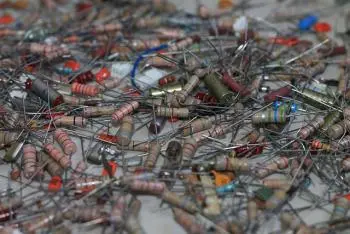
Capacitors, also known as capacitors, are essential components in electronics and electrical engineering. These devices are used to store electrical energy in the form of electrical charge on their conductive plates.
As technology advances, various types of capacitors have emerged, each designed to fulfill a specific function. In this article, we will describe the most common types of capacitors and their applications.
Film capacitors
Film capacitors are one of the most common and versatile types. They are composed of two metal plates separated by a dielectric film, which can be made of materials such as polyethylene, polyester or polypropylene. These capacitors offer high precision and low power loss, making them ideal for high frequency applications.
Film capacitors are widely used in filtering circuits, signal coupling, timing, and high-quality audio applications such as hi-fi sound systems. They are also non-polarized, meaning they can be connected in any direction in a circuit without problem.
Electrolytic capacitors
 Electrolytic capacitors are known for their high charge storage capacity in a relatively small space. These capacitors use an electrolyte (usually a saline solution or conductive paste) as their dielectric. They are divided into two main subtypes: aluminum electrolytic capacitors and tantalum electrolytic capacitors.
Electrolytic capacitors are known for their high charge storage capacity in a relatively small space. These capacitors use an electrolyte (usually a saline solution or conductive paste) as their dielectric. They are divided into two main subtypes: aluminum electrolytic capacitors and tantalum electrolytic capacitors.
-
Aluminum electrolytic capacitors are widely used in power supplies and filtering circuits due to their high capacity and low cost. However, they must be connected in the correct polarity, as reversing the polarity can damage them.
-
Tantalum electrolytic capacitors, on the other hand, are more expensive, but offer greater stability and durability. They are used in high-quality, high-frequency applications such as mobile phones and communication devices.
Ceramic capacitors
Ceramic capacitors are a popular choice in electronics due to their low cost and availability. These capacitors use ceramic as a dielectric and are suitable for high frequency, low current applications. They come in different types depending on the ceramic material used, such as NP0, X7R and Y5V, which vary in terms of stability and operating temperature.
Ceramic capacitors are ideal for decoupling, denoising and signal coupling applications in digital circuits. However, it is important to note that the capacitance of ceramic capacitors can vary with temperature and voltage, which can affect their performance in critical applications.
Tantalum capacitors
Tantalum capacitors are similar to electrolytic capacitors, but use tantalum instead of aluminum as the conductive material. They are known for their high stability and low dielectric loss, making them ideal for high frequency and high audio quality applications.
This type of capacitor is used in high-tech devices such as smartphones, laptops and satellite navigation systems where exceptional performance is required.
Polypropylene capacitors
Polypropylene capacitors are a popular type of capacitor for high quality audio and signal filtering applications. They use polypropylene as a dielectric material and are known for their high stability and low dielectric loss.
These types of capacitors are used in high fidelity circuits, timers, oscillators and other devices where precision is essential.
Polystyrene capacitors
Polystyrene capacitors are similar to film capacitors, but use polystyrene as the dielectric material.
They are known for their stability, low dielectric loss and high precision. These capacitors are used in high quality audio, signal filtering and timing applications.
Variable Capacitors
Unlike fixed capacitors, variable capacitors allow the capacitance to be adjusted as needed. This type of capacitor is used in applications where fine tuning of the capacitance is required, such as in tunable radios and voltage controlled oscillators.
Variable capacitors can be of two main types: rotating plate capacitors and variable dielectric capacitors.
-
Those with rotating plates use moving plates to vary the overlap of the plates, which changes the capacitance.
-
Variable dielectric ones use a dielectric that can be moved to change the capacitance.
Starting and working capacitors
Start and work capacitors are used in single-phase electric motors to assist in starting and continuous operation of the motor. The start capacitor provides the initial power needed to start the motor, while the work capacitor improves the performance and efficiency of the motor during normal operation.
These capacitors are common in appliances such as refrigerator compressors and fan motors. They are especially important in applications where high starting torque and long-term efficient operation are needed.
SMD Capacitors (Surface Mount)
SMD capacitors are a variant of traditional capacitors designed to be mounted on the surface of a printed circuit board (PCB). These types are compact and widely used in modern electronic devices such as smartphones, tablets and laptops.
SMD capacitors come in a variety of types, including ceramic capacitors, tantalum capacitors, and electrolytic capacitors. They are essential in the manufacture of compact and high-density electronic devices.
High voltage capacitors
High voltage capacitors are used in applications that require the handling of voltages significantly higher than those handled by conventional capacitors. These capacitors are designed to withstand voltages of hundreds or even thousands of volts.
Typical applications of high voltage capacitors include automotive ignition systems, x-ray generators, and high voltage applications in laboratories and research equipment.
Supercapacitors capacitors
Supercapacitors, also known as double-layer capacitors or electrolytic double-layer capacitors (EDLC), are a special class of capacitors designed to store large amounts of electrical energy. Unlike other types of capacitors, supercapacitors store energy in the form of electrostatic charge at the interface between the dielectric and the conducting plates.
Supercapacitors have high energy density and long life, making them ideal for power backup applications, energy recovery in regenerative braking, and energy storage in renewable systems.